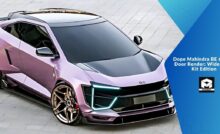Mahindra XUV700 Safety Rating and Global NCAP Fact Sheet


Mahindra XUV700 Bags 5-Star Safety Rating; Here is the Global NCAP Fact Sheet
Already winning the hearts of Indian SUV lovers, the Mahindra XUV700 has now won safety ratings as well. The Global NCAP has given the newly launched car a complete 5-star safety rating. In the most recent round of crash testing performed by the safety watchdog, the SUV received five stars for adult occupant protection and four stars for child occupant protection. The car examined by GNCAP has the most basic safety equipment, such as dual airbags, ABS, and Isofix child seat anchorages.


The XUV700 earned 16.03 out of a possible 17 points for adult occupant protection and 41.66 points out of a potential 49 points for child occupant protection. It was deemed to provide enough protection for the driver’s and passenger’s head, neck, chest, and knees. The body shell and footwell section of the SUV have been evaluated as “stable” and “capable of withstanding further loadings.” The possible injuries to the front passengers are likewise minor, and it is comforting that there are no orange or red flags on the crash test dummy injury assessments.
In terms of passenger safety, the top-spec XUV700 variant includes ESP, seven airbags, driver drowsiness detection, auto high-beam assist, and booster headlights, as well as Advanced Driver Assistance Systems (ADAS), features such as Forward Collision Warning (FCW), Autonomous Emergency Brakes (AEB), Lane Keep Assist, Adaptive Cruise Control (ACC), and Smart Pilot Assist or traffic assist (AT only).
According to Global NCAP, the XUV700 might be enhanced by making optional equipment like side-body airbags, side head curtain airbags, Electronic Stability Control (ESC), and three-point belts in all sitting positions standard across the range. Alejandro Furas, Secretary-General of Global NCAP, stated on the occasion that Mahindra has set a new standard for adult protection by being the first Indian-made and-owned company to provide Autonomous Emergency Braking (AEB) as a safety feature.
Recent Posts
Fifteen Best Loan Programs Within India: Quick Loans At Your Own Disposal
MoneyLion prides by itself on providing an all-in-one mobile banking encounter, which consists of accessibility…
Dragona Joestar Jojo’s Bizarre Encyclopedia
Jolyne then fulfills along with Emporio in add-on to Endure user Climate Record, who can…
Landmark Forest Journey Park
Presently There are usually a pair associated with hussle gym areas with tons associated with…
Typically The Finest Gym Leggings 2025 For Typically The Gym, Running, Yoga And A Lot More
Our women’s petite gym leggings usually are flawlessly designed in order to suit women in…
Whenever Deforestation Takes Place In Addition To Need To Not Nature Sustainability
Several animal clades likewise web host pathogens along with special features that boost their particular…
Boost Your Car’s MPG: Top 10 Fuel-Saving Tips for Savvy Drivers
Do you watch your hard earned money go down the drain that is the gas…

